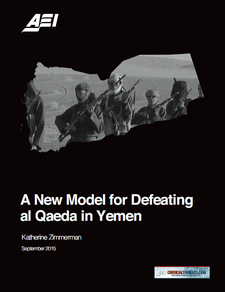{{currentView.title}}
September 10, 2015
A New Model for Defeating al Qaeda in Yemen
EXECUTIVE SUMMARY
 The terrorist threat from Yemen is growing. Al Qaeda in the Arabian Peninsula (AQAP), still likely the most potent al Qaeda terrorist threat to the US homeland, has expanded and strengthened as the Yemeni state has collapsed. AQAP’s success buttresses the global al Qaeda network, which remains cohesive despite the rise of the Islamic State in Iraq and al Sham (ISIS).
The terrorist threat from Yemen is growing. Al Qaeda in the Arabian Peninsula (AQAP), still likely the most potent al Qaeda terrorist threat to the US homeland, has expanded and strengthened as the Yemeni state has collapsed. AQAP’s success buttresses the global al Qaeda network, which remains cohesive despite the rise of the Islamic State in Iraq and al Sham (ISIS).
 |
AQAP’s capabilities to conduct transnational attacks—for example, to design bombs that can travel undetected—remain. The question is when, not if, AQAP will strike next. ISIS also now has a foothold inside Yemen that will only increase under current conditions. ISIS may not be plotting an attack against the West from Yemen, but its expansion into Yemen builds the ISIS narrative and will only serve to strengthen ISIS globally. The current US approach to Yemen, christened the “Yemen model,” has failed alongside the Yemeni state.[1]
America’s counterterrorism partnership ran through the Yemeni government and relied on Yemeni military forces to fight AQAP on the ground. In the wake of the collapse of that partnership, the US is now backing a Saudi-led military intervention in Yemen in hopes of returning that government, or some iteration of it, to power in order to pick up where the partnership left off. But the Yemeni military forces are so degraded today that they will not be able to fight AQAP effectively once the current conflict ends, and this effort to resuscitate the Yemen model does not appreciate that the US approach was not working in the first place.
The American strategy to fight AQAP in Yemen prioritized a military response to AQAP’s threat. American air strikes targeted AQAP leadership, and Yemeni forces disrupted AQAP ground movements. Nonetheless, AQAP reemerged after a major offensive against it in 2012 and again in 2014. Part of its resilience has come from AQAP’s ability to exploit local popular grievances, which the Yemeni government has avoided addressing for decades and which afford the group the operational and territorial latitude so vital to its success.
These local grievances are driving Yemen’s own instability. The fundamental and clear lesson from past experience is that the terrorist threat from Yemen is not susceptible to a kinetic solution. As daunting a task as it is, .
Complicating matters, the Kingdom of Saudi Arabia and the Islamic Republic of Iran have pulled Yemen into their expanding regional proxy war, a growing challenge for any Yemen strategy. Even more problematic for the United States, both Tehran and Riyadh have picked sides in Yemen’s civil war, and neither is fighting AQAP. Perceptions of the US role from both Riyadh, an important ally in the region, and Tehran, a linchpin of the new Iran deal, mean that most decisions made by Washington will appear to be tipping the regional balance to one or the other player.
The US must identify a way forward and lead a coordinated regional response in Yemen. Specifically, Washington must work with both regional and local partners to defeat AQAP and to negotiate a political solution to the current crisis by
- Engaging in a multitiered effort to negotiate a political settlement among Yemeni stakeholders to end the national-level conflict and signal clearly that the Zaydi Shi’a al Houthi movement must be a part of Yemen’s future;
- Supporting subnational actors to stabilize local dynamics and understand and address underlying grievances;
- Leading a ground offensive against AQAP by coordinating and supporting partnered local forces and conducting direct-action operations to destroy the direct and imminent threat from AQAP; and
- Managing and mitigating a humanitarian crisis by addressing the immediate needs of the population, prioritizing aid delivery to key terrain, and delivering targeted aid through US Agency for International Development channels similar to those run in Iraq or Afghanistan.
These efforts, particularly the ground offensive against AQAP, will generate a reaction. US personnel deployed to Yemen will be in harm’s way, although there are steps to take to minimize that risk. AQAP and ISIS will both probably seize the opportunity to kill Americans, and we must prepare ourselves for casualties. It may be much more appetizing to fight from the sky, but the only way to win will be on the ground.
A win against al Qaeda in Yemen will last only if it is part of a global strategy to operate against al Qaeda, ISIS, and like-minded groups. The proposed approach should not be taken as a model for such a global fight, as experience shows that there is no single answer to this complex problem. Instead, similar concepts must be developed for all the theaters in which al Qaeda and ISIS operate today, which together will comprise a comprehensive strategy to defeat al Qaeda and ISIS.
